Key takeaways:
- Misinformation often exploits emotions and biases, making critical engagement essential in evaluating the validity of information.
- Trustworthy sources are crucial for informed discussions; understanding the reputation of sources protects against misleading narratives.
- Effective strategies for verifying information include cross-referencing diverse sources, fact-checking, and scrutinizing original context.
- Sharing accurate information benefits from clarity, visual aids, and openness to feedback, enhancing understanding and engagement.
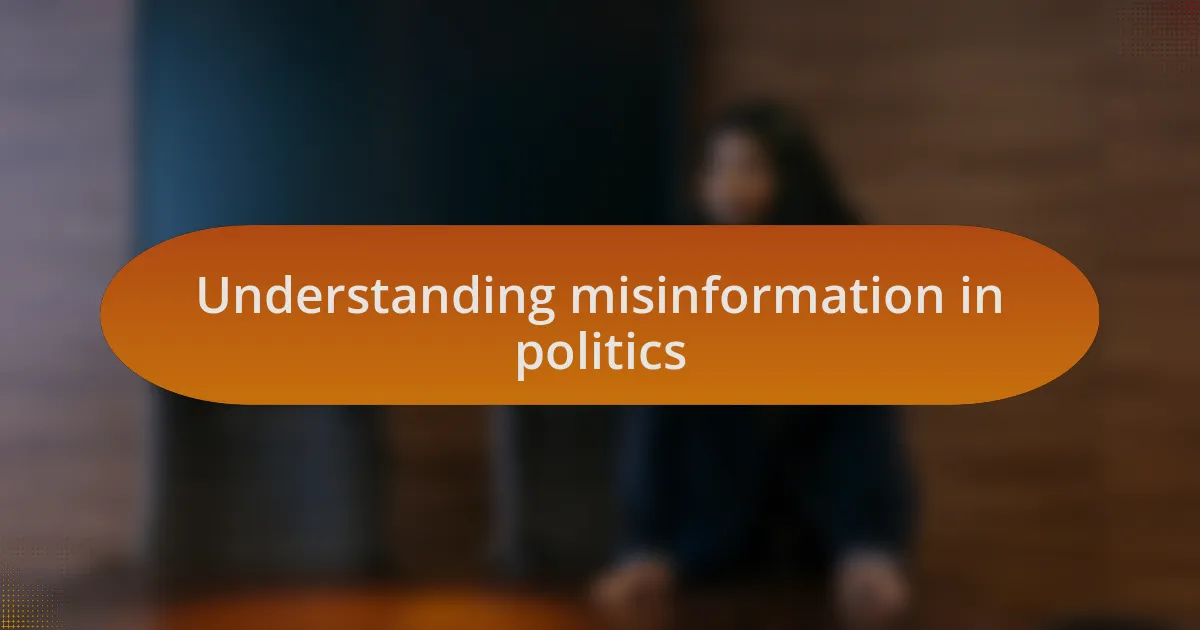
Understanding misinformation in politics
Misinformation in politics is not just about falsehoods; it often preys on emotions and beliefs, making it deeply persuasive. I remember a heated discussion I had with a friend after they shared a sensational article that distorted the truth about a political event. It struck me how easily we can fall into the trap of believing something because it resonates with our fears or hopes.
One key aspect of understanding misinformation is recognizing its source. I often ask myself, “Why was this information shared and by whom?” It’s essential to dig deeper and examine the motives behind the narratives we encounter. This gets to the heart of the issue—are we critically engaging with the content, or simply reacting to the sensationalism designed to provoke?
I find it fascinating how misinformation can thrive on social media, where a single misleading post can reach thousands within minutes. I’ve seen firsthand how rapidly a misleading claim can spiral out of control, leading to widespread misunderstanding. This makes it crucial for us to develop a habit of questioning the validity of information before spreading it further.
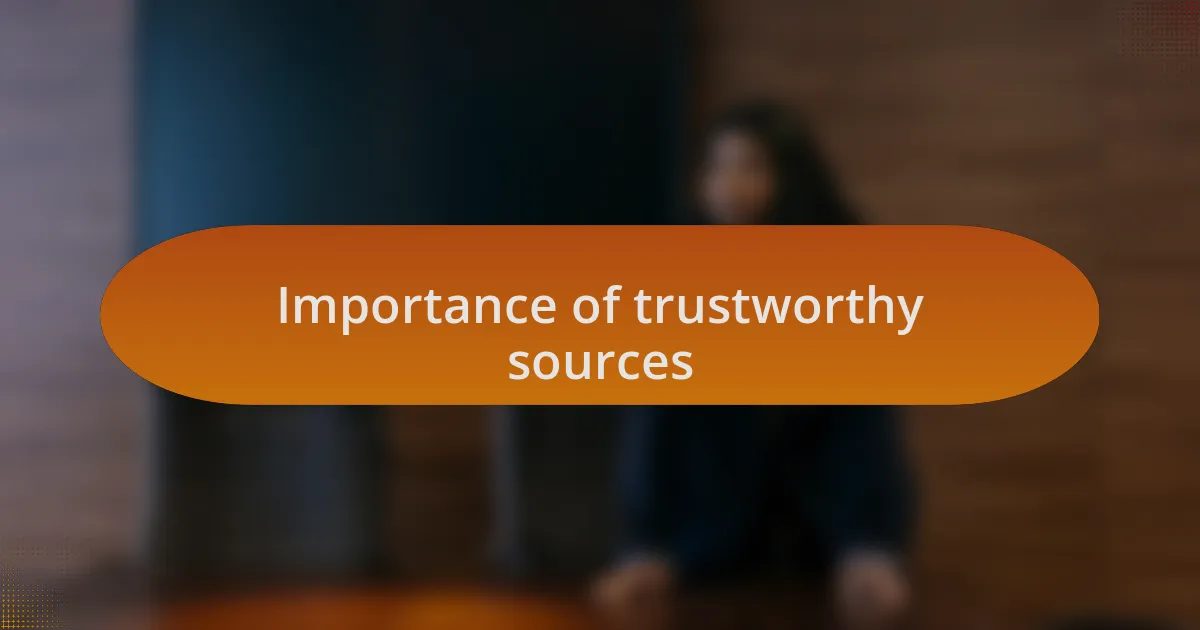
Importance of trustworthy sources
Trustworthy sources play a vital role in navigating the complex landscape of political information. I recall a time when I stumbled across a viral video that seemed to capture a significant political event. Initially, it stirred a mix of outrage and disbelief within me, but then I paused and thought about where I had seen it. That moment of doubt led me to research the channel that shared it, revealing a history of biased reporting. It was a clear reminder that reputation matters in the realm of information dissemination.
There’s an undeniable emotional component tied to the content we consume; it shapes our perceptions and influences our actions. I often find myself reflecting on how my reactions might change if I knew a source was credible. When my friends rely on well-known outlets, I feel more confident in sharing those views. This mutual trust in the sources serves as a protective barrier against fallacies that could otherwise polarize our discussions.
Ultimately, fostering a relationship with reliable information not only informs my understanding but also empowers me to engage thoughtfully in conversations. I frequently ask myself, “What drew me to this piece of information?” With every article or post I encounter, I’m reminded of the responsibility I carry—ensuring that the facts I share are grounded in authenticity, thus shielding both myself and my community from misinformation’s slippery grasp.
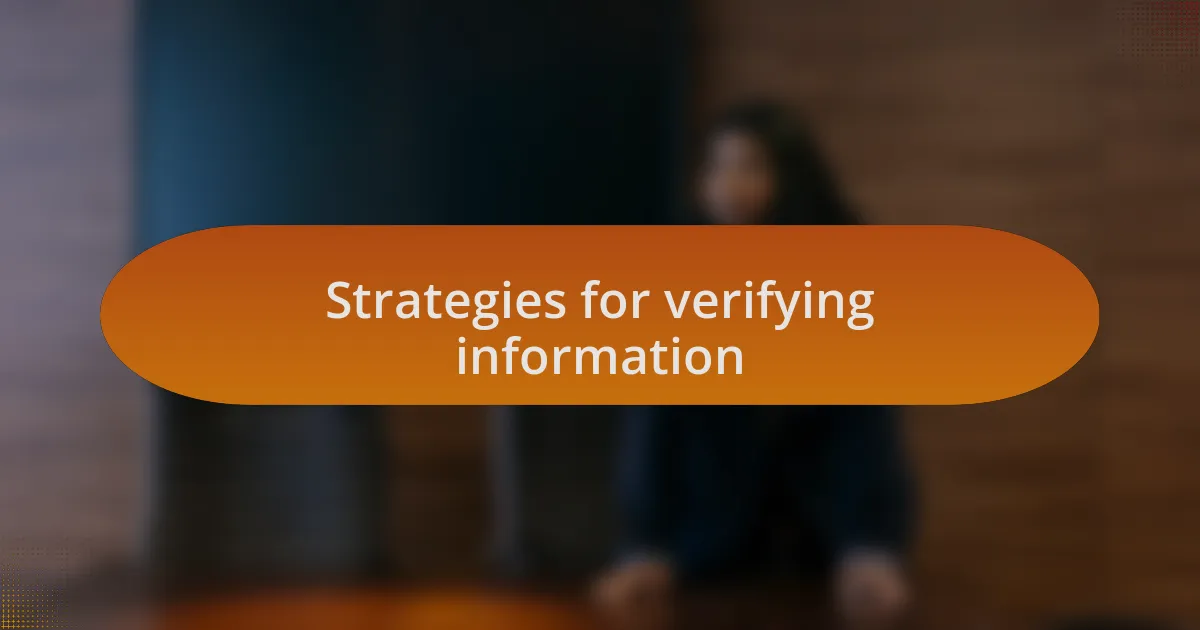
Strategies for verifying information
When it comes to verifying information, one of my go-to strategies is cross-referencing multiple sources. For instance, I remember during an election cycle when a rumor spread about a candidate’s policy change. Instead of accepting it at face value, I consulted three different news websites with diverse ideological leanings. This approach not only provided clarity but also highlighted perspectives I hadn’t considered, ultimately enriching my understanding of the topic.
Another crucial method is fact-checking, which can feel tedious but pays off tremendously. I often use dedicated fact-checking sites, like Snopes or PolitiFact, to validate suspicious claims. I recall discovering a meme that confidently declared a false statistic about voter turnout. By quickly checking it, I not only saved myself from spreading misinformation but also felt a sense of empowerment in being able to debunk the myth for my friends. Isn’t it satisfying to know the truth?
Moreover, I’ve learned that scrutinizing the original context of information is essential. I once encountered a quote that was circulated widely on social media as a supposed statement by a public figure. After digging deeper, I found it was taken out of context, distorting its original meaning significantly. Have you ever experienced a similar moment of realization? It reinforced for me how easy it is to misinterpret facts if we don’t look at the bigger picture. Understanding the context helps prevent misunderstandings and cultivates a more informed dialogue.
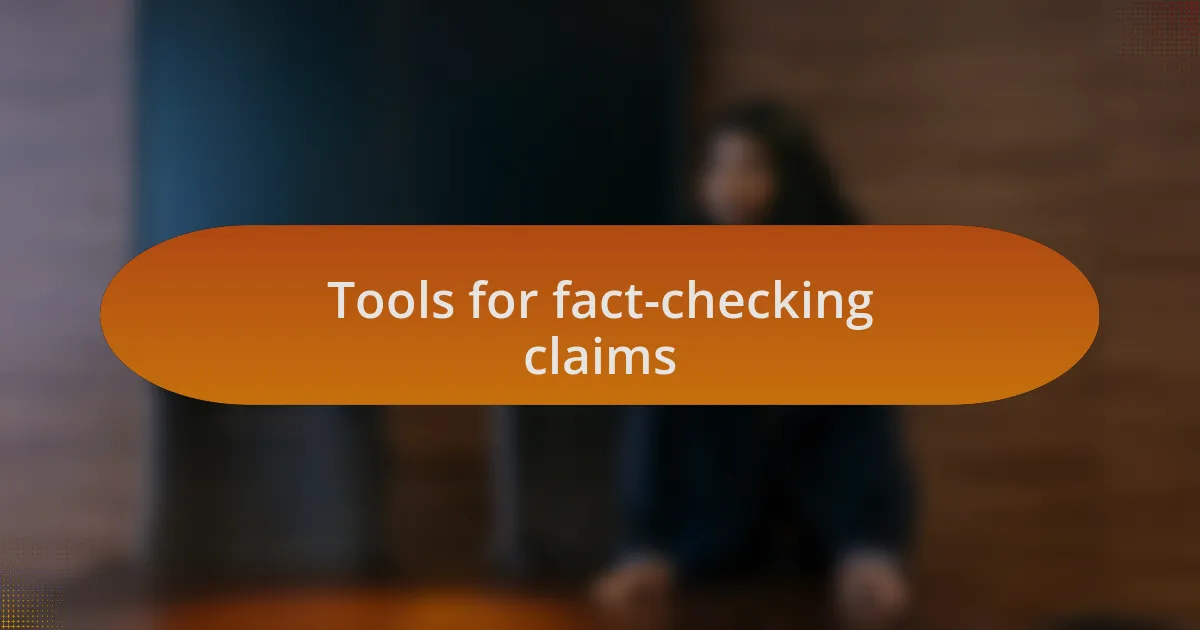
Tools for fact-checking claims
One of the most effective tools I’ve used for fact-checking claims is Google’s advanced search features. I remember a time when a viral post claimed that a certain governing body had made a drastic policy change. By using specific search phrases, I was able to find reputable reports that confirmed or refuted the claim within minutes. It’s incredible how a simple search adjustment can lead to such clear and factual results, don’t you think?
Another resource I find invaluable is the browser extension “NewsGuard.” This tool evaluates news sites and provides ratings based on journalistic standards. I once came across an outrageous headline from a lesser-known site that seemed too sensational to be true. With NewsGuard, I quickly discovered that this site had a dubious reputation for accuracy. This little safety net gives me peace of mind as I navigate the complex web of information.
Lastly, I often turn to social media verification tools, like Crowdtangle or Hoaxy, to track the spread of claims. During discussions about misinformation in a community forum, I used these tools to visualize how a misleading video was gaining traction. It was eye-opening to see the pathways of misinformation and how swiftly it can spread. Have you ever wondered how easily misinformation travels across platforms? Recognizing these patterns is a crucial step in combatting fabrications before they become mainstream beliefs.
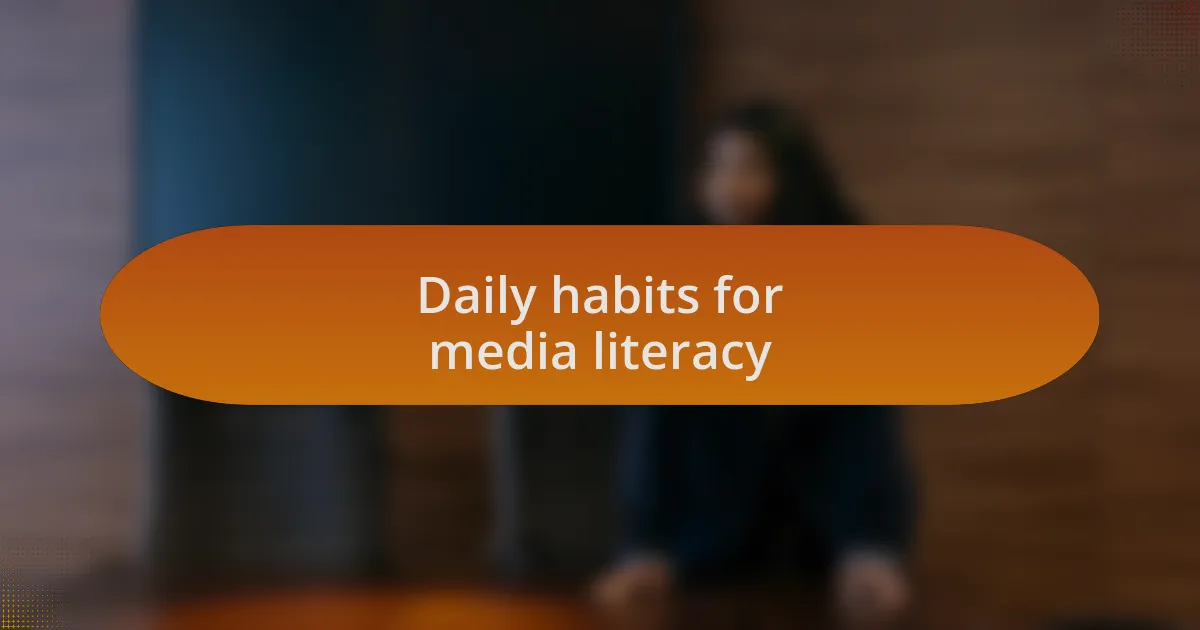
Daily habits for media literacy
Staying informed requires establishing daily habits that foster media literacy. I make it a point to dedicate at least 15 minutes each morning to reading diverse news sources. This practice not only broadens my understanding but also helps me identify biases in various outlets. Isn’t it fascinating how different perspectives can illuminate the same story in completely different ways?
Another habit I’ve embraced involves critically evaluating headlines before diving into the articles. There was a time when I clicked on a sensational headline that promised shocking revelations but ended up being misleading. By taking a moment to consider whether the headline aligns with the content, I’ve saved myself from unnecessary confusion. Have you ever found yourself lured in by clickbait, only to feel let down when the truth unfolded? Being mindful of this tendency has transformed my approach to consuming news.
Engaging in discussions about the news with friends or family also plays a vital role in strengthening my media literacy. I often pose questions to my inner circle, such as, “What do you think the authors omitted in this article?” Reflecting together not only deepens our understanding but also keeps us accountable for the information we share. It’s interesting how collaborative discussions can reveal blind spots and enhance our collective awareness.

Sharing accurate information effectively
When sharing accurate information, clarity is crucial. I’ve learned that distilling complex ideas into simple, digestible points resonates more with my audience. For example, during a recent discussion about a political issue, I shared a concise summary with key facts rather than overwhelming my friends with data. It sparked a lively conversation, and I realized how effective brevity can be in promoting understanding.
Visual aids can also enhance the way we communicate accurate information. On social media, I often use infographics or charts that neatly present statistics. I remember posting an infographic about voter turnout, which led to numerous shares and a deeper engagement from my followers. Have you ever noticed how a well-crafted visual can draw attention and invoke curiosity? It’s a reminder that sharing information doesn’t have to be monotonous or complex; creativity plays a vital role.
Being open to feedback is another vital strategy I employ. After sharing my thoughts on a recent legislative change, a friend pointed out an aspect I hadn’t considered. Rather than feeling defensive, I embraced it as an opportunity for growth. Isn’t it rewarding when a conversation challenges your viewpoints and leads to greater insight? Emphasizing this openness not only enriches my understanding but also strengthens the trust within my community.
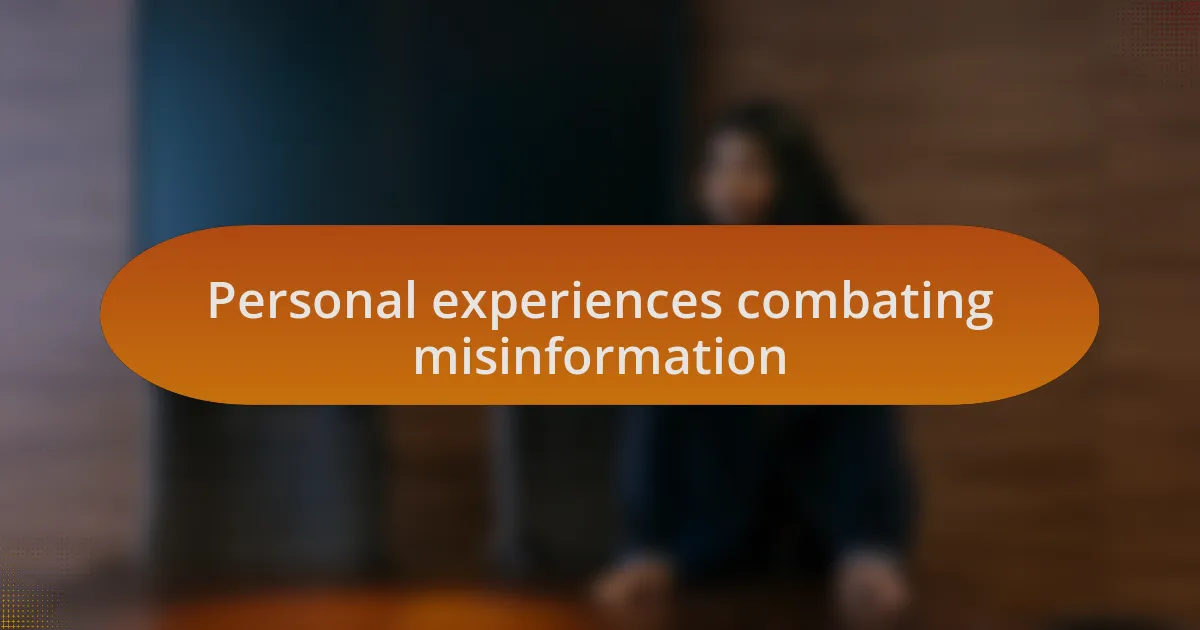
Personal experiences combating misinformation
In my daily interactions, I often find myself gently correcting misinformation when I encounter it. Just last week, a colleague shared a sensational headline about a political figure that was clearly false. Instead of dismissing it, I took a moment to share a reliable source that debunked the claim. I felt a mix of responsibility and relief, knowing that I did my part to promote truth within my circle.
There are times when misinformation can strike close to home, impacting loved ones directly. A family member fell for a viral conspiracy theory about a recent election. I remember sitting down with them and presenting the facts, feeling the weight of the moment as I thought about the consequences of believing such inaccuracies. Have you ever felt that urgency to protect someone from misleading narratives? The conversation turned momentous as it opened their eyes and strengthened our bond, leaving us both with a deeper understanding of the importance of verified information.
Using personal stories can also serve as a powerful tool in combating misinformation. I once shared my experience of fact-checking a popular claim during a community meeting. As I recounted the process, I could see the audience’s expressions shift from skepticism to curiosity. It made me reflect: isn’t it fascinating how our narratives can reshape perceptions? In the end, sharing my journey not only educated others but also reinforced my belief that personal engagement is a vital weapon in the fight against misinformation.